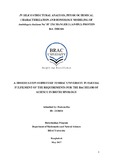In silico structural analysis, physicochemical characterization and homology modeling of Arabidopsis thaliana Na+/H+ exchanger 2 protein
Abstract
Along with climate change, salinity has a detrimental effect on plants. It can cause susceptibility towards pathogens, halt proper growth and thus lead to food insecurity. Therefore, it is necessary to comprehend the ways in which plants adapt to abiotic stress. NHX- antiporter facilitates the exchange of Na+ and H+ across the membranes and these proteins help plants to tackle salinity by compartmentalizing Na+ from cytoplasm to vacuoles via generated electrochemical gradient by H+ pumps, hence considered as one of the significant protein that is capable to catalyze Na+ in vacuoles. These classes of proteins are exhibited in many plants such as Arabidopsis Thaliana. As such, it is necessary to determine the structure of the protein encoded by the NHX gene in Arabidopsis thaliana. Determining the structure can reveal the protein-protein interaction network and identify regions such as, active sites, in the protein. Also, the structure between AtNHX1 and AtNHX2 can be compared to find the similarities and differences between them using in silico approach. Bio-computational analyses of the target protein were performed using an array of online bioinformatics tools and databases and the homology model was developed using 4 different software (I-TASSER, Phyre2, Easy Modeller and Swiss Model) and the best model was selected upon evaluation. In addition, the secondary structural motifs were identified within the model. The results suggested that structure generated by Swiss Model, was the best amongst the four. It had the highest stereo-chemical quality scores and was considered to be the least unusual. The model consisted of α/β/γ topology where a single β-sheet constituted the β-hairpin as observed in the secondary structure schematic and topology diagrams. It was predicted that the presence of the β-hairpin allowed the protein to act as a membrane channel protein to facilitate the exchange of Na+ and H+. These factors were also present in AtNHX1, which further validates the structure. However, the position of the β-hairpin in AtNHX1 is different to AtNHX2. The β-hairpin on AtNHX1 was found in between amino acid 197 (Serine) till 199 (Aspartine). The second strand ranged from residue 209 (Phenylalanine) till residue 211 (Leucine). In AtNHX2, the beta hairpin spanned across amino acid residue 366 (Serine) and 367(Asparagine) and the other from amino acid residue 373 (Glutamine) to 374 (Serine). Moreover, the two proteins exhibited different classes of β-hairpin. However, further research is necessary to understand functional difference in between AtNHX1 and AtNHX2.

